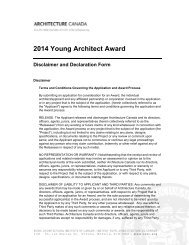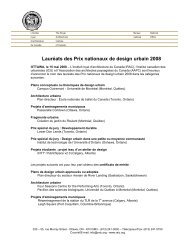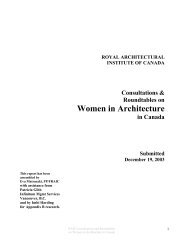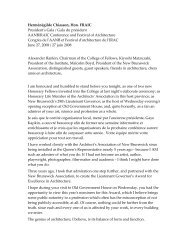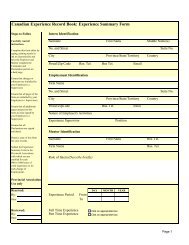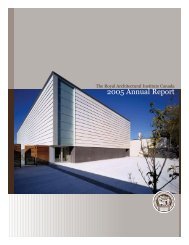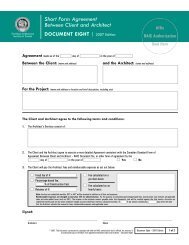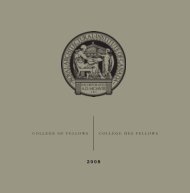Benchmark Study on Green Buildings - Royal Architectural Institute ...
Benchmark Study on Green Buildings - Royal Architectural Institute ...
Benchmark Study on Green Buildings - Royal Architectural Institute ...
You also want an ePaper? Increase the reach of your titles
YUMPU automatically turns print PDFs into web optimized ePapers that Google loves.
the rest of the SAI program is set to commence in 2007. It is anticipated that by 2015,<br />
American solar power will provide 5-10 GW of new electric capacity (equivalent to the<br />
amount of electricity needed to power 1-2 milli<strong>on</strong> homes) to the U.S. grid, avoid 10<br />
milli<strong>on</strong> metric t<strong>on</strong>s per year of CO 2 emissi<strong>on</strong>s, and employ 30,000 new workers in the PV<br />
industry.<br />
Incentive example for water c<strong>on</strong>servati<strong>on</strong>:<br />
Various incentives also exist across the United States for c<strong>on</strong>servati<strong>on</strong> efforts c<strong>on</strong>cerning<br />
other resources. The East Bay Municipal Utility District (EBMUD) of eastern San<br />
Francisco offers a set of rebate programs to help and reward c<strong>on</strong>sumers for their water<br />
efficiency and c<strong>on</strong>servati<strong>on</strong> efforts. These programs include rebates of between $50 and<br />
$125 for the purchase and installati<strong>on</strong> of certain efficient clothes washing machines, $125<br />
for high-efficiency toilets (HETs), free water-saving showerheads and faucet aerators,<br />
and rebates for any hardware change that will result in predictable water savings. The<br />
‘hardware change’ rebate covers up to half the cost of the equipment leading to the<br />
increased water efficiency. Any hardware change leading to water savings is eligible for<br />
this rebate. The EBMUD water-c<strong>on</strong>servati<strong>on</strong> effort also provides free technical assistance<br />
through informative workshops, <strong>on</strong>-site water surveys, water c<strong>on</strong>servati<strong>on</strong> studies, and<br />
waterwise self-survey toolkits.<br />
Clean Energy States Alliance (CESA):<br />
Additi<strong>on</strong>ally, 14 states across the U.S. with established clean energy funds or programs<br />
have banded together to promote clean energy technologies. The 14 states involved in<br />
this initiative are Ariz<strong>on</strong>a, California, C<strong>on</strong>necticut, Illinois, Massachusetts, Minnesota,<br />
New Jersey, New York, Ohio, Oreg<strong>on</strong>, Pennsylvania, Rhode Island, Washingt<strong>on</strong> and<br />
Wisc<strong>on</strong>sin. These states are c<strong>on</strong>sidered to be the most advanced in the country in terms of<br />
green building and resource c<strong>on</strong>servati<strong>on</strong> initiatives, and make up The Clean Energy<br />
States Alliance (CESA). CESA is a n<strong>on</strong>profit organizati<strong>on</strong> comprised of members from<br />
the aforementi<strong>on</strong>ed 14 states, 16 clean energy funds and two state agencies. It provides<br />
informati<strong>on</strong> and technical services to its members and works with them to build and<br />
expand clean energy markets in the United States. The CESA also collects and<br />
disseminates informati<strong>on</strong> and analysis, c<strong>on</strong>ducts original research, and helps to<br />
coordinate activities of the state funds. In the process of assisting the state funds, they<br />
also hope to help other state officials, clean energy developers, and envir<strong>on</strong>mentalists<br />
who share an interest in developing cleaner energy markets. In additi<strong>on</strong>, the CESA hosts<br />
a listserve for official representatives of state funds, issues a periodic e-newsletter about<br />
state funds, writes case studies <strong>on</strong> actual projects funded by the states, and hosts<br />
c<strong>on</strong>ferences to help the state fund officials develop their renewable energy programs. The<br />
main objective of the CESA is to increase the quality and quantity of clean energy deals<br />
to greatly expand the clean energy market in the United States. For a detailed listing of<br />
American federal and state incentives for increased energy efficiency, look in the<br />
Database of State Incentives for Renewable Energy (DSIRE) at http://www.dsireusa.org/.<br />
Nati<strong>on</strong>al Renewable Energy Laboratory (NREL):<br />
The Nati<strong>on</strong>al Renewable Energy Laboratory (NREL) is the nati<strong>on</strong>’s primary laboratory<br />
for renewable energy and energy efficiency R&D. NREL is the principal research<br />
45



